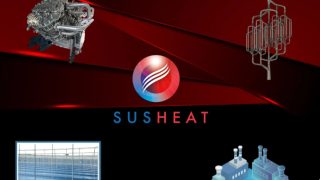-
SUSHEAT – driving industrial heat decarbonisation
Date posted:
-
-
Post Author
Tracey Biller
-
![]()
A 14-partner consortium spanning eleven European countries is developing a system combining high temperature heat pumps, thermal storage, solar thermal, and digital twin to decarbonise industrial heat up to 250°C.
SUSHEAT (Smart Integration of Waste and Renewable Energy for Sustainable Heat Upgrade in Industry) is a Horizon Europe Research & Innovation Action developing a next-generation high-temperature heat solution for processes up to 250°C. The project launched on 1 May 2023 and runs for 48 months.
Roughly half of industrial final energy is used as heat and much of it is still produced by fossil fuels or lost as low-grade waste. SUSHEAT targets this underused resource by upgrading, storing, and distributing heat so factories can meet process temperatures reliably while reducing their carbon footprint.
According to an article contributed to the Enlit publication by the consortium and published on 16 October, EU industrial heat demand amounts to ~1,600TWh per year, a scale that makes incremental gains insufficient. Importantly, a large share of process heat sits in the 100–200°C band – prime territory for efficient electrified heat upgrade, and the range targeted by SUSHEAT.
Electrifying heat in these ranges can deliver material CO2 reductions, particularly when paired with waste heat recovery, renewables, and storage.
SUSHEAT’s Stirling-based high temperature heat pump raises low-grade heat sources – waste heat, ambient or solar input – up to 150–250°C, delivering hot water, steam and thermal oil at high output temperatures. The heat pump used in the SUSHEAT concept achieves a performance coefficient (COP) of 2.8 with a temperature ratio of 1.26, operating in a temperature range between 165-200°C.
Many food and beverage processes, such as pasteurisation, sterilisation, CIP, drying, and baking) operate in stable medium temperature ranges with recoverable heat and are well-suited to SUSHEAT’s upgrade plus storage approach. This is also true of textile dyeing and finishing, and portions of chemicals, petrochemicals, and metals treatments including washing, drying, and curing.
Two use cases are planned to validate the SUSHEAT pathway:
The Mandrekas pilot at a dairy in Greece is assessing high temperature heat pump integration for pasteurisation and cleaning-in-place (CIP), with thermal energy storage for flexibility and solar thermal as a supplementary source.
The Pelagia pilot at a fish meal and oil facility in Norway is upgrading waste heat for drying and processing of fish oil and animal feed and stabilising thermal supply with digital control.
Read more here.

